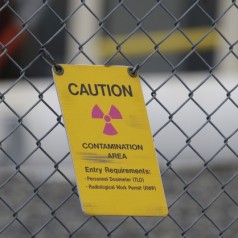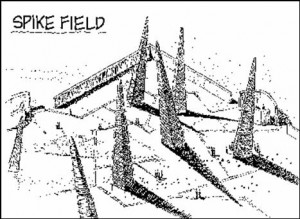A Disturbing Message Across Time & Culture

The United States Department of Energy is currently designing a project in the desert of New Mexico. It’s a dump site where they plan to dump and store over 500,000 barrels of radio active waste. The waste is being drilled 1/3 of a mile down into a “geophysical-inert thick salt formation”. This waste will be considered dangerous for up to 10,000 years.
One of the few positives to come out of this story is the fact that the government has done extensive research to try and design a specific architecture around the site. The purpose of the design is to warn future generations and cultures that the site is dangerous and should not be disturbed. 10,000 years is a long time to wait, and at least the designers of the project have accepted that they don’t know what could happen between now and then. They wanted to leave behind a timeless message that a band of humans coming across in the future would understand and stay away from – regardless of massive language or cultural changes.
In trying to go beyond written language, there has been interesting work done in the understanding of archetypes and how humans feel about their surroundings. In a newsletter article titled: “An Architecture of Peril” requirements and suggestions have been laid out for creating a landscape that will warn people away from the certain doom that would await them if they were to disturb the site.
I highly recommend reading the full article. It made me think of the messages that ancient cultures might have left for us, and our own efficacy in interpreting them. But I was also intrigued by the recommendations and whether or not I thought an ancient culture would be able to figure it out. For example, the article recommends obviously that nothing with moving parts will endure, and that metal may be scavenged for future uses.  All the components of the site must be able to last for thousands of years with no maintenance. Other recommendations however are more reflective like the one requiring that “Forms should avoid “perfection.” Historically, cultures have used the perfect or “ideal” geometric forms in places that embody their highest aspirations and ideals. Our designs seek irregularity and broken geometries”.
All the components of the site must be able to last for thousands of years with no maintenance. Other recommendations however are more reflective like the one requiring that “Forms should avoid “perfection.” Historically, cultures have used the perfect or “ideal” geometric forms in places that embody their highest aspirations and ideals. Our designs seek irregularity and broken geometries”.
Here is a sample sketch of what the topography of the site might look like. It is certainly creepy. While it may be effective in deterring future cultures from disturbing the site, it is unfortunate that this may be one of the few architectures that survive us. It leaves a very disturbing and uncomfortable legacy of our time here. And in a sad way, that might be the most accurate message we could convey.
If you would like to read the entire article you can view it here.







 The Natural Arts Community in Durham Region is made up of Organic Farmers, Yoga Studios, Holistic Practitioners and any other person or business who is dedicated to creating a more conscious world. Our mission is to make the public aware of these amazing businesses and people. We are growing an alternative marketplace for people who are ready to live a more conscious life.
The Natural Arts Community in Durham Region is made up of Organic Farmers, Yoga Studios, Holistic Practitioners and any other person or business who is dedicated to creating a more conscious world. Our mission is to make the public aware of these amazing businesses and people. We are growing an alternative marketplace for people who are ready to live a more conscious life.
Recent Comments